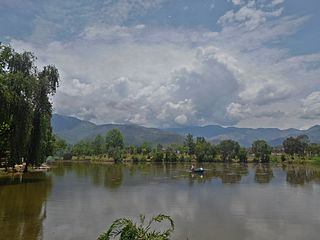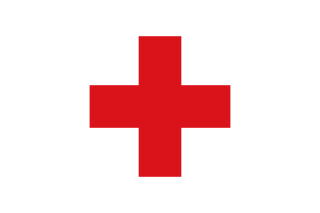
The Magars, also spelled Mangar and Mongar, are Tibeto-Burman ethnic group native to Nepal, representing 6.9% of Nepal's total population according to the 2021 Nepal census. They are one of the main Gurkha tribes.

Dolpa District, is a district, located in Karnali Province of Nepal, It is one of the seventy-seven districts of Nepal and one of ten district of Karnali. The district, with Dunai as its district headquarters, covers an area of 7,889 km2 (3,046 sq mi) and has a population (2023) of 43,000. Dolpa is the largest district of Nepal in terms of area.

Rukum District was a "hill" and "mountain" district some 280 km (170 mi) west of Kathmandu partially belonging to Lumbini Province and partially to Karnali Province before split into two districts Western Rukum and Eastern Rukum after the state's reconstruction of administrative divisions in 2017. Rukum covers an area of 2,877 km2 (1,111 sq mi) with population of 207,290 in 2011 Nepal census. Musikot was the district's administrative center.

Surkhet District is a district in Karnali Province of mid-western Nepal. Surkhet is one of the ten districts of Karnali located about 600 kilometres (373 mi) west of the national capital Kathmandu. The district's area is 2,489 square kilometres (961 sq mi). It had 288,527 population in 2001 and 350,804 in 2011 which male comprised 169,461 and female 181,381. Its district headquarters, Birendranagar, is the capital of Karnali Province. It is serving as a business hub and document center for Karnali province. According to population, development, road links, landforms, climate, many peoples are migrating here. After becoming province capital developmental activities are boosted and are in peak level. All the governmental works are carried here. Birendranagar is beautiful valley surrounded by hills having moderate climate.
The Kham Magars, also known in scholarship as the Northern Magars, are a Magar Kham language or Kham Kura speaking indigenous ethnic tribal community native to Nepal. In general, Kham Magars refer to themselves using their clan name and the ethnic identity of Magar. Kham Magar clan names include Budha/ Budhathoki, Gharti, Pun and Roka, and each clan is subdivided into many sub-clans name. The language of the Kham Magars is called Magar Kham among other glottonyms. It is estimated that about 71,000 Kham Magars live in the Middle Hills of mid-western Nepal, in the districts of Rukum, Rolpa, Baglung and Myagdi. Scattered communities also live in Jajarkot, Dailekh, Kalikot, Achham, and Doti districts as well as in the capital city of Kathmandu.
Sarki/Mijar is an occupational caste in Nepal. They are found in the region of the Himalayas, Nepal, across the hills of Darjeeling & Kalimpong and in Terai area of Dooars. They are experts in playing their musical instrument "Madal" and performing dance in a group which is also called “Khayali Marooni”. According to the 2021 Nepal census, Sarki makes up 1.55% of Nepal's population. Sarki are referred to in the Nepali and Thakali languages.
Kami is an Indo-Aryan Nepali speaking group that primarily worked as metalsmiths. Later Nepal abolished its grading system. The tribal designation of Khas is given in some contexts. the Government of Nepal legally abolished the caste-system and criminalized any caste-based discrimination, including "untouchability" - in the year 1963 A.D. With Nepal's step towards freedom and equality, Nepal, previously ruled by a Hindu monarchy was a Hindu nation which has now become a secular state, and on 28 May 2008, it was declared a republic, ending it as the Hindu Kingdom. In spite of being the important occupational caste and ethnic group whose metal craving arts are globally recognized but still struggling to be recognized as it is considered as the serving occupation. The most people of this caste group are in absolute poverty to raise the voice and educate themselves to be in a good position to find the history. So they are compelled to face the inhuman discrimination of society. Even though it is illegal to discriminate people based on their caste, these people are widely discriminated in Nepal. A large portion of people still discriminate Kami and other being suppressed castes. This problem is faced on rural areas as well in cities when it comes to marriage and building relation. Although it is not absolute truth as problems related to caste based discrimination are slowly coming to improvisation. The level in educated youth is not as same as before as many educated and thoughtful youth are fully aware that these problems are rooted not only in tradition and culture, but also religion. Caste based discrimination and violence are a grim reality of Nepali society with numerous people losing their lives due to racially motivated mobs. Both the Government and many other INGO are working hand-in-hand in order to uproot the problem by targeting grassroot issues such as education, awareness and employment.

Nepal Red Cross Society is an independent, volunteer-based and humanitarian organization that delivers humanitarian service and support to the vulnerable people in an impartial and neutral manner. It came into being on 4 September 1963. Nepal Red Cross Society was officially registered in Nepal after Nepal Government acceded to the Geneva Conventions. Having been recognized by the International Committee of the Red Cross (ICRC) and affiliated to International Federation of Red Cross and Red Crescent Societies (IFRC) on 1 October 1964.

The Far-Western Development Region was one of Nepal's five development regions. It was located at the western end of the country and had its headquarters in Dipayal.

Lumbini Province is a province in western Nepal. The country's third largest province in terms of area as well as population, Lumbini is home to the World Heritage Site of Lumbini, where according to the Buddhist tradition, the founder of Buddhism, Gautama Buddha was born.

Sudurpashchim Province is one of the seven provinces established by the new constitution of Nepal which was adopted on 20 September 2015. It borders the Tibet Autonomous Region of China to the north, Karnali Province and Lumbini Province to the east, and India's states of Uttarakhand and Uttar Pradesh to the west and south, respectively. The province covers an area of 19,539 km2, or about 13.22% of the country's total area.
Mahat (Nepali: महत) is an Ekthariya chhetri surname among Nepalese, of Khasa heritage. The name may have originated when one of the Jumli Malla kings in medieval times made his younger brother, Dharma Malla, chief of staff in the army. This granted Dharma Malla the title of Mahat (Kshatriya) (meaning The Great One), and as a result, his descendants started using 'Mahat' as their surnames.
The Thakuri is a Royal caste forming the core of the ruling class in Nepal. This term is a Nepali adaptation of the Indian title Thakur, which translates to 'master of the estate'. The term denotes the royal descendants of kings of Khasa Kingdom, Gandaki kingdom and the Kingdom of Nepal.

Eastern Rukum is a mountain district of Lumbini Province of Nepal situated along the Dhaulagiri mountain range. It is also the only mountain district of the province with its tallest mountain Putha Hiunchuli situated in the west end of Dhaulagiri II mountain chain, at an elevation of 7,246 meters. The drainage source of ancient Airavati river, one of the five sacred rivers of Buddhism, lies in the lesser Himalayas of the district. With a Dhaulagiri mountain range, lakes, Magar culture and its political history, Eastern Rukum has been among the top travel destinations of Nepal as designated by the Government of Nepal.

Western Rukum a part of Karnali Province, is one of the seventy-seven districts of Nepal. Musikot is the headquarter of the district.
Maide is a village located in Bheri municipality in Jajarkot District of Karnali Province of Nepal. The aerial distance from Maide to Nepal's capital Kathmandu is approximately 323 km.

Dungeshwor Temple is one of religious affairs in Dailekh district in Karnali Province. This place is located in Lower Dungeshwor, the highest place in Dailekh district. This places is located in the confluence of Loohre and Karnali river, at the level of 544 meters from the sea level. In ancient times, here is believed to be the end of the day. There are two temples by Shideshwor Mahadev and Dungal Temple in Dungeshwor. According to Ancient holy flame myth and Vaishwankar myth of Dailakh district, this area is considered to be a place in the center of five famous Panchkoshi, five in Dailekh district. Because of these diverse reasons it is considered to be a mantle. This bridge is currently located in the village of Naule Katuwal connected to Dullu Municipality. This campusphere is located near the Karnali highway in Karnali river and Larkakhola's turbulence. Interesting historical context has been popular about the predecessor of this loop. Dailekh has two places named Lower Dhungeshwor and Upper Dhungeshwor.
On 27 May 2020, six youths were killed in Rukum district of western Nepal in a caste-related community violence. The bodies of two Dalit men were found in the Bheri River, a major tributary of the Karnali River, on 27th May. The two men were identified as 21-year-old Nawaraj BK and Tika Ram Nepali. Later, four additional bodies were found, those of Ganesh Budha, Lokendra Sunar, Sanju BK and Govinda Sahi. Following the incident, a detailed police investigation was carried out for two years. According to the Nepal police, when BK and 18 others went to Soti village in Chaurjahari, the villagers allegedly attacked the group and chased them to the river and killed them. Based on the evidences, in 2023, court ordered 24 villagers for the life imprisonment and another two individuals for two years imprisonment.

Shree Bala Tripura Sundari Devi Bhagawoti Temple, regarded as the Purna Shakti Peeth, is a significant pilgrimage site in Shaktism. The temple is located near Tripurakot on the bank of the Thuli Bheri river in the Dolpa district of Nepal, and is said to have been built in the 12th century. About 20,000 pilgrims visit the temple every year, mostly during the Dashain festival. Among the many temples of the Hindu goddess Tripura Sundari, this is the only one that offers the blessing of her daughter, Bālā Tripurasundarī.
The structure of this municipality is Dandagaon, Lahan, Khagenkot, Ragda and Bhagwati Ga.V.S. It was merged and renamed after Nalgad Khaela and the name of the municipality remained Nalgad Municipality. The area of this municipality is 387.44 square kilometers. has been It is the largest municipality in terms of area among the municipalities in Jajarkot district. The total population here is 28,858. There are a total of 13 wards in this municipality. The municipal executive office of this municipality is in Ward No. 7 Dalli and the border is Rukum district in the east, Kuse district in the west, Barekot district in the north. And in addition to Dolpa district, there is Bheri municipality in the south.












